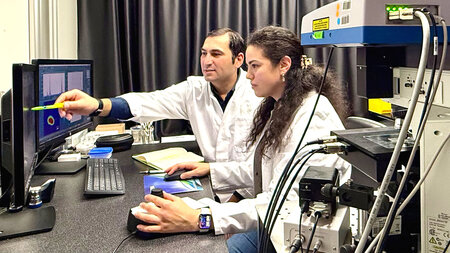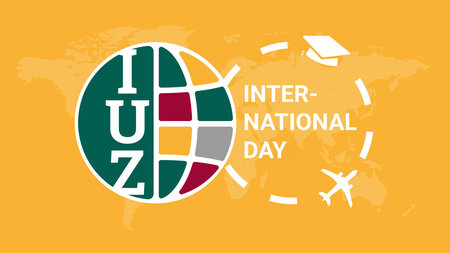Microplastics – Fighting an Invisible Danger
Chemnitz University’s Professorship of Conveying and Plastics Engineering and its partners intend to develop a market-ready process for efficient sample collection in water
-

Prof. Dr. Michael Gehde (left) and Mirko Albrecht of the Professorship of Conveying and Plastics Engineering observe microplastic particles floating in water. Photo: Karoline Hofmann
Plastics are versatile and useful for many applications – from everyday plastic bags to highly-stressed safety components in airplanes. Due to their extraordinary diversity of types and functionalities, plastics are applied in almost every industry and area of our lives today. Although plastics do offer certain distinct advantages over other materials and have significantly contributed to technological advances, negative headlines continue to make the rounds. The small particles known as “microplastics” are a known environmental pollutant.
Microplastics are formed primarily as a result of improper disposal of plastics, whereby they are not broken down like natural products. Instead, they disintegrate into small particles, some of which are smaller than 5 millimeters in diameter. Microplastic particles are found all over the world, including in the Arctic, on the ocean floor and on deserted islands. Microplastics are even found increasingly inside living organisms. However, considering the extent of microplastics pollution around the globe, we know surprisingly little about it from a scientific perspective. How much plastic is in the ocean or in the soil? How did it get there? How does it behave in this environment? How do humans or animals react to it? These are only a few of the questions which have become the focus of research in this domain.
In Germany, the Federal Ministry of Education and Research (BMBF) is taking on this issue with its research focus initiative called “Plastic in the Environment – Sources – Sinks – Solutions.” More than 100 institutions in the academic and private sectors are involved in the initiative’s 18 joint projects. Together, they are researching the entry of plastic into the environment as well as solutions to reduce plastic’s environmental impact. Chemnitz University’s Professorship of Conveying and Plastics Engineering is a member of a joint project titled “Representative Research Strategies for an Integrative System Understanding of Specific Inputs of Plastics into the Environment” (RUSEKU). The project will receive 3.1 million euros in funding from the Federal Ministry of Education and Research over three years.
“In addition to the academic understanding of microplastic entry sources, causes and paths, market-ready procedures for efficient microplastic sampling are to be developed in cooperation with the participating companies,” says Prof. Dr. Michael Gehde, Head of the Professorship of Conveying and Plastics Engineering at Chemnitz University. The sampling methods being developed need to be precise, reproducible and transferable, as they are to be applied in various areas of the water cycle system. “We also need to pay attention to the fact that there is not just one kind of microplastic. Rather, it is made up of many types of plastic particles of varying sizes, forms and characteristics,” continues Mirko Albrecht, member of the professorship’s scientific staff. For this purpose, defined microplastic particles are produced realistically and tested for representative recovery in laboratory and semi-technical simulation facilities for the sampling procedures. According to Gehde, the developed sampling system will create a basis for legislative evaluation and for standardization.
Homepage for the BMBF’s “Plastic in the Environment” Project: https://bmbf-plastik.de/en/
More information is available from Mirko Albrecht, Tel.: +49 371 531-34826, E-mail: mirko.albrecht@mb.tu-chemnitz.de
(Translation: Sarah Wilson)
Matthias Fejes
11.07.2018




